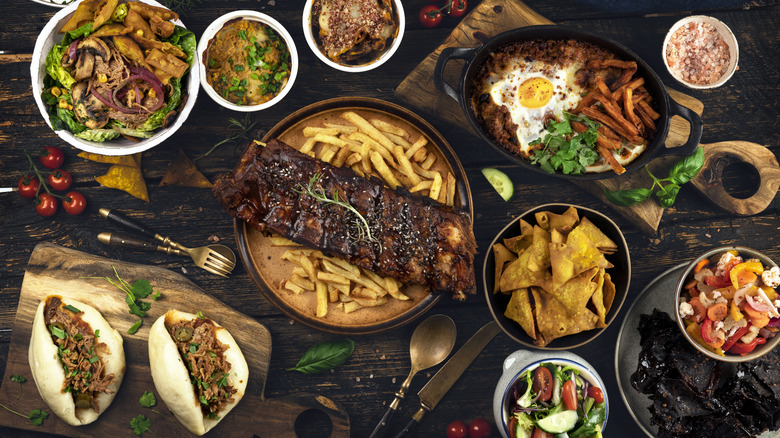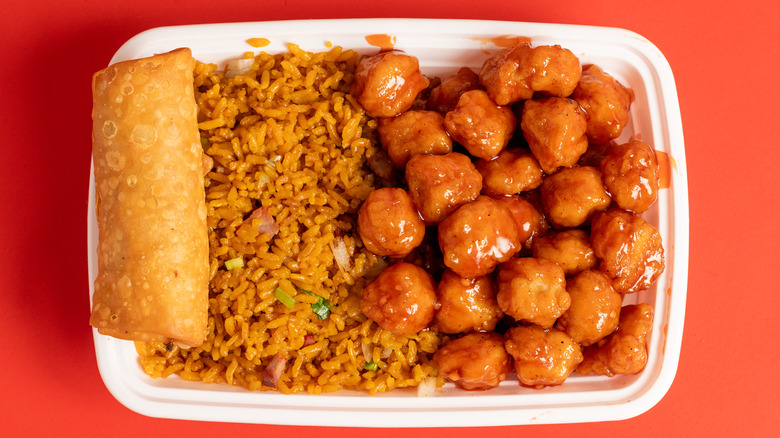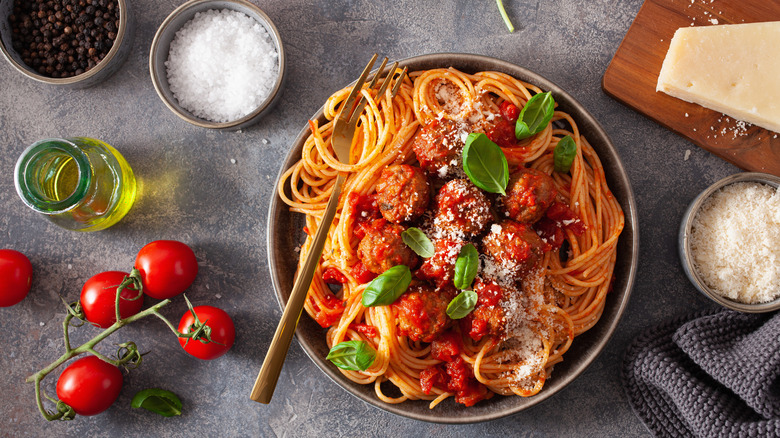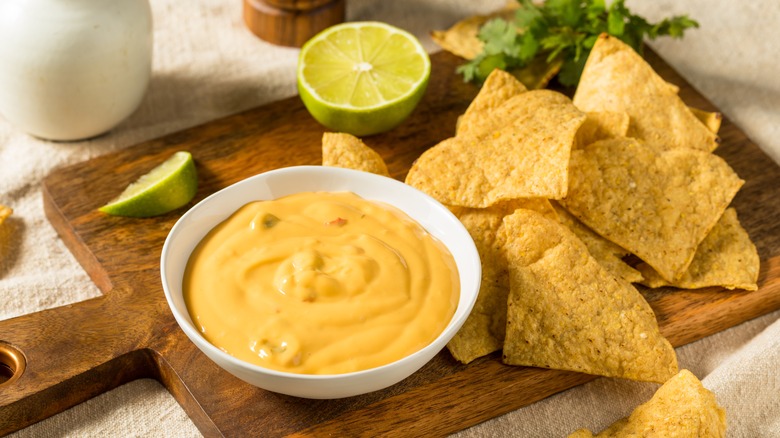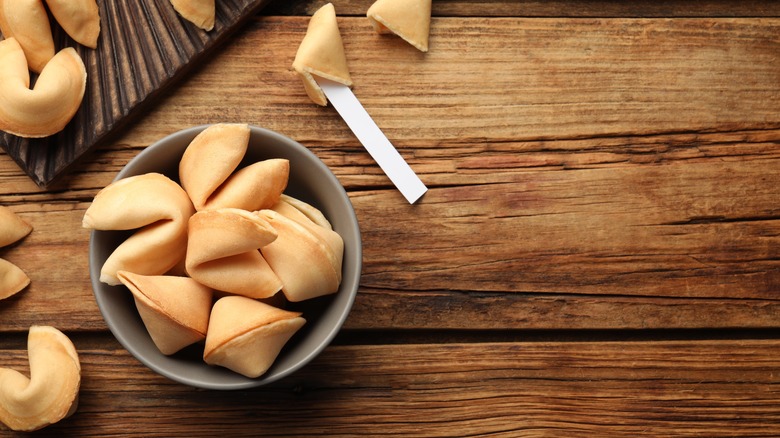5 'International' Foods That Were Invented In The US
The American culinary landscape is eclectic to say the least. From the Greek inspired Skyline Chili of Cincinnati, Ohio to the Jewish roots of Texas brisket barbecue, it seems that almost every American classic has cultural roots that go beyond the red, white, and blue. Of course, the influence of international cuisine on American food is well known, and one of the more celebrated aspects of American culture. But what about the twist that America puts on international cuisine?
What you may not know is that many of your favorite international dishes are actually uniquely American inventions. We're not just talking about the American hot dog, either, which has strayed far away from its German roots, but rather seemingly international foods that are entirely, and uniquely, American in origin. These are foods that are a testament to cultural fusion, or in the case of number three on this list, cultural confusion, that could only be produced in the United States. So let's dive in and see just how patriotic your tastes really are. You might just be surprised at how many of your worldly favorites make the list.
Orange Chicken
It's saucy, crunchy, sweet, and sour. Orange chicken in an American-Chinese food classic. A staple on most takeout Chinese menus in the United States, orange chicken is nothing short of ubiquitous. It combines classic flavor combinations of Chinese cuisine, with influences of spice, sweetness, and a sour edge that pairs well with a savory scoop of fried rice or lo mein. But this Chinese take-out classic isn't actually Chinese at all. In fact, it's a uniquely American invention that hails from Panda Express, one of the United States' most popular fast food chains.
Orange chicken was invented by Panda Express chef Andy Kao in 1987, and comes from one of their Hawaii locations. Kao, who is from Taiwan, is a professionally trained chef whose background actually focused on cooking French cuisine. Kao came up with the dish as a modification of one of the restaurant's more popular bone-in chicken dishes, and Kao's saucy (and boneless) innovations soon made orange chicken a classic at Panda Express — and beyond. In the thirty-plus years since its invention, orange chicken has made its way to almost every Chinese buffet and take-out menu across the United States.
Meanwhile, General Tso's chicken, from which Panda Express' orange chicken was partially inspired, is also a uniquely American dish. Both draw inspiration from the salty and sour foods of Hunan Province, which is located in the southern central region of China. However, their breaded, fried, and sugary nature sets them apart from traditional foods of the region, which tend towards cured meats and savory dishes.
Spaghetti and meatballs
You have the perfect Italian getaway planned. You've been studying up on your Italian and booking hotels near historical landmarks. But if a part of your dreams of Italy include sharing a plate of spaghetti and meatballs "Lady and the Tramp" style, you might want to go ahead and unpack your suitcase (or book a vacation to Disney World instead), because you'll be hard pressed to find a plate of the Italian-American staple in the mother country itself. That's right, spaghetti and meatballs isn't actually an authentically Italian dish.
Unlike with orange chicken, however, there is no one exact inventor we know of to thank for this dish. In fact, the origins of spaghetti and meatballs are a bit foggy. What we do know is that the dish was invented by Italian immigrants in America during the late 19th or early 20th century. The meatballs were a particularly American innovation; many Italian immigrants had previously struggled to afford meat in Italy, but found that the ingredient was relatively affordable in their new homeland. Because of this, meatballs became a staple among Italian immigrants (and many Americans). Meanwhile, marinara sauce was a popular sauce for southern Italians, and both it and spaghetti itself was readily available in the United States. Combining the three came almost as an inevitability: part convenience, part ingenuity, with a good serving of new opportunity. And though the dish may not be properly Italian, it is the perfect ode to the contributions of Italian Americans to the rich landscape of American food. That said, you should probably make it at home, since you may want to think twice before ordering spaghetti and meatballs at an Italian restaurant.
German chocolate cake
Some food items on this list are a product of culinary innovation by immigrants, while others are uniquely engineered dishes designed for food chains that play into the cultural landscape of their originating country. It's easy to see the Italian culinary heritage of spaghetti and meatballs, and even though orange chicken isn't authentically Chinese, you can certainly see where the inspiration for the dish comes from. But in the case of German chocolate cake, you'd be hard pressed to find any actual cultural connection to Germany, because, well, there isn't one. German chocolate cake, which is often mistaken for a German invention (which, given the name, is understandable), is actually purely American.
The German chocolate cake was first created in 1957 in Dallas, Texas. The cake was developed by a Mrs. George Clay, who named it after the brand of baking chocolate used in her recipe: German's Sweet Chocolate. Surely, you must be thinking, the chocolate brand was German, right?
Wrong. German's Sweet Chocolate was actually named for its creator, Samuel German, who reportedly wasn't German either (NPR says his own origins are either American or English, but it's not clear which one). However, just because the cake isn't an authentic German creation doesn't mean it isn't delicious. It features a caramel and coconut filling, and it's a decadent dessert as American (or perhaps more American) than apple pie. If you're looking for a delicious dessert to serve at the end of a meal, you can hardly do better.
Tortilla chips
What's a visit to you local Mexican (or Tex-Mex) restaurant without a basket of fresh, hot tortilla chips with salsa or queso? So you wouldn't be out of line for thinking that tortilla chips must have a strong foothold in the history of Mexican cuisine. You would be wrong, however, as those crispy fried tortilla chips are actually an entirely American invention.
The tortilla chip is actually a relatively new invention. The chip was invented in Los Angeles, California in the 1940s, and is typically credited to a woman named Rebecca Webb Carranza. Carranza, who was born in Mexico, was the co-owner of a tortilla factory in California. The factory, which used an automated tortilla press, often produced misshapen tortillas that could not be sold on their own. This surplus of misshapen products led Carranza to a genius idea: cutting and frying the defective tortillas to sell as chips. The idea clearly took off, and eighty years later the tortilla chip stands as one of the most popular snacks on the market today, accumulating an impressive $36 billion in sales in 2022 alone. Considering that Mexican food currently makes up about 10 percent of all American restaurants, it's not hard to imagine that the beloved tortilla chip may have had a little something to do with that.
Fortune cookies
Whether you save them for the end of your meal or crack into them as soon as you open your bag of takeout, an order of Chinese food simply wouldn't be complete without fortune cookies. The folded wafer cookies are light and crisp, containing a small strip of paper containing a message for whomever opened the dessert treat. However, as you've probably guessed by now, fortune cookies are not actually Chinese at all — they're an American invention by way of Japan.
A predecessor of the fortune cookie called a "fortune cracker" in Japanese was served in Japanese teas shops as far back as the 1870s. However, this cracker was not made with vanilla flavoring, but sesame and miso, and it made its way over to the United States in the late 19th or early 20th century. It's not completely clear who invented the current iteration of the cookie, but some believe that Makoto Hagiwara, the owner of a Japanese tea garden in San Francisco, California originated the cookie as we know it. Others claim that the inventor was a Chinese-American by the name of David Jung, who was based in Los Angeles. He owned the Hong Kong Noodle Company, and in 1918 began filling his version of the cookie with Bible verses.
But no matter which way you crack it, the fortune cookie is, and will remain, a staple of American Chinese cuisine (and you don't need a fortune cookie to know that).
